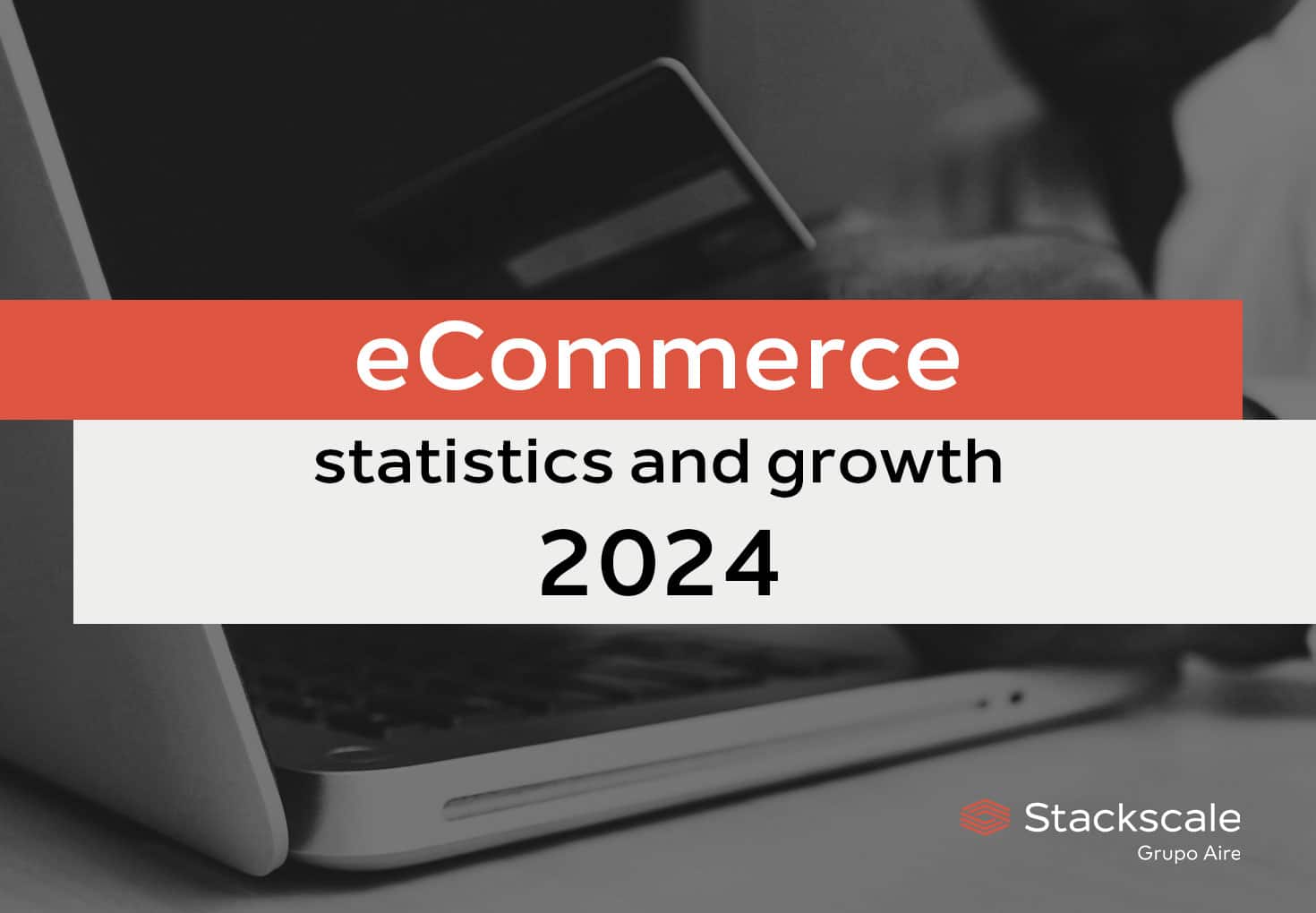eCommerce has experienced continued growth during the last decade. In this article we have collected some eCommerce statistics in 2024 and over the last decade showing how its adoption has increased over the years.
Global eCommerce market growth
Global eCommerce sales are expected to surpass 5.8 trillion Euros (6.3 trillion USD) in 2024 and 6.3 trillion Euros (6.8 trillion USD) by 2025, according to eMarketer eCommerce statistics and forecasts. The forecast for retail eCommerce sales growth is about 9,4% in 2024; a growth rate that is expected to decrease slightly during the following triennium.
These predictions continue to show a stabilization following the skyrocketing of eCommerce growth worldwide in 2020-2021, due to lockdowns and restrictions. As a result of the increase in digital activity during the pandemic, retail eCommerce sales grew above 25% in 2020 and above 15% in 2021.
These eCommerce statistics not only demand for businesses to stay up to date to new trends and technologies, but also to explore international markets in order to leverage further opportunities. Thus making specialized cloud solutions and complementary services such as Content Delivery Networks a priority for many growing eCommerce sites.
Revenue in the eCommerce market worldwide
Revenue in the eCommerce Market worldwide surpassed 2,800 billion Euros (3,100 billion USD) in 2023 and it is expected to surpass 3,300 billion Euros (3,600 billion USD) by 2024, according to Statista’s eCommerce market insights.
Revenue by product category in 2023
Looking closer to the revenue by product category, these were the 10 sectors with the highest revenue in 2023:
- Electronics: ~725 billion Euros (~781 billion USD).
- Fashion: ~625 billion Euros (~673 billion USD).
- Food: ~343 billion Euros (~370 billion USD).
- Beverages: ~194 billion Euros (~209 billion USD).
- DIY and Hardware Store: ~186 billion Euros (~201 billion USD).
- Furniture: ~174 billion Euros (~188 billion USD).
- Media: ~169 billion Euros (~182 billion USD).
- Beauty and Personal Care: ~140 billion Euros (~151 billion USD).
- Tobacco Products: ~96 billion Euros (~104 billion USD).
- Toys and Hobbies: ~74 billion Euros (~80 billion USD).
Growth in the number of users buying online in the European Union
According to data from eCommerce statistics for individuals in the European Union of Eurostat, the average of Internet users purchasing online in the EU was about 70% in 2023. While the average in the Euro area was slightly higher: about 71% of Internet users shop online.
Evolution of the percentage of online shoppers 2019-2023
The percentage of Internet users purchasing online has evolved during the last five years. The growth rate varies depending on the country, but all of them have generally experienced a significant increase in the number of online buyers. The following table shows the percentage of online shoppers that purchased something on the Internet during the 12 months previous to the annual survey.
| Country | 2019 | 2020 | 2021 | 2022 | 2023 |
| EU average | 60% | 65% | 67% | 68% | 70% |
| Eurozone | 63% | 67% | 69% | 69% | 71% |
| Austria | 62% | 66% | 63% | 66% | 72% |
| Belgium | 66% | 73% | 75% | 75% | 75% |
| Bulgaria | 22% | 31% | 33% | 41% | 45% |
| Croatia | 45% | 55% | 57% | 56% | 59% |
| Cyprus | 39% | 47% | 54% | 50% | 57% |
| Czechia | 64% | 72% | 75% | 77% | 78% |
| Denmark | 84% | 89% | 91% | 88% | 89% |
| Estonia | 68% | 68% | 70% | 71% | 73% |
| Finland | 73% | 76% | 79% | 79% | 79% |
| France | 70% | not available | 76% | 76% | 77% |
| Germany | 79% | 83% | 76% | 76% | 77% |
| Greece | 39% | 46% | 54% | 59% | 58% |
| Hungary | 49% | 60% | 66% | 70% | 70% |
| Iceland | 80% | 83% | 85% | not available | not available |
| Ireland | 67% | 74% | 87% | 85% | 86% |
| Italy | 38% | 44% | 51% | 49% | 51% |
| Latvia | 47% | 56% | 62% | 62% | 62% |
| Lithuania | 48% | 54% | 60% | 60% | 61% |
| Luxembourg | 72% | 79% | 81% | 81% | 80% |
| Malta | 58% | 63% | 65% | 68% | 68% |
| Netherlands | 81% | 87% | 89% | 88% | 92% |
| Norway | 82% | 85% | 92% | 92% | 91% |
| Poland | 54% | 61% | 61% | 65% | 64% |
| Portugal | 39% | 45% | 52% | 54% | 55% |
| Romania | 23% | 38% | 38% | 46% | 50% |
| Slovakia | 60% | 62% | 75% | 77% | 77% |
| Slovenia | 56% | 63% | 71% | 63% | 66% |
| Spain | 58% | 63% | 67% | 68% | 69% |
| Sweden | 82% | 84% | 87% | 86% | 89% |
| United Kingdom* | 87% | 90% | not available | not available | not available |
*Until Brexit.
Comparison of the percentage of online buyers 2013-2023
When comparing data over the last decade, we notice an important growth in online shopping adoption as a regular shopping option within the EU. Some countries, such as Bulgaria, Estonia and Romania, have tripled and even quadrupled the percentage of online buyers between 2013 and 2023.
| Country | 2013 | 2023 |
| EU average | 47% | 70% |
| Eurozone | 47% | 71% |
| Austria | 54% | 72% |
| Belgium | 48% | 75% |
| Bulgaria | 12% | 45% |
| Croatia | 26% | 59% |
| Cyprus | 25% | 57% |
| Czechia | 36% | 78% |
| Denmark | 77% | 89% |
| Estonia | 23% | 73% |
| Finland | 65% | 79% |
| France | 59% | 77% |
| Germany | 69% | 77% |
| Greece | 25% | 58% |
| Hungary | 29% | 70% |
| Iceland | 56% | not available |
| Ireland | 46% | 86% |
| Italy | 20% | 51% |
| Latvia | 32% | 62% |
| Lithuania | 26% | 61% |
| Luxembourg | 70% | 80% |
| Malta | 46% | 68% |
| Netherlands | 69% | 92% |
| Norway | 73% | 91% |
| Poland | 32% | 64% |
| Portugal | 25% | 55% |
| Romania | 8% | 50% |
| Slovakia | 44% | 77% |
| Slovenia | 36% | 66% |
| Spain | 32% | 69% |
| Sweden | 73% | 89% |
| United Kingdom* | 77% | not available |
*Until Brexit.
Comparison of the percentage of online buyers by age group 2013-2023
When comparing data grouped by age over the last decade, data in the EU and the Euro area is very similar. The age group whose number of online buyers has increased the most is that of the Internet users between 55 and 74 years old — from about 27% in 2013 to about 50% in 2023.
| Age group | 2013 (EU) | 2023 (EU) |
| 16-24 years old | 58% | 81% |
| 25-54 years old | 55% | 80% |
| 55-74 years old | 27% | 50% |
Most online purchased products and services in the European Union in 2023
Moreover, according to data from Eurostat, these were the most online purchased products and services in the EU in 2023, during the three months previous to running the survey:
- Clothes, shoes and accessories (40%).
- Tickets to events (21%).
- Films and series as a streaming service or downloads (20%).
- Food delivery and catering services (17%).
- Cosmetics and beauty and wellness products (16%).
- Music as a streaming service or downloads (16%).
- Furniture, home accessories and gardening products (15%).
- Printed books, magazines and newspapers (13%).
- Medicine and dietary supplements (13%).
- Computers, tablets, mobile phones and accessories (12%).
To sum up, according to eCommerce statistics worldwide, the eCommerce market has not stopped growing over the last years and it is expected to continue growing.
The number of users that purchase products and services online keeps rising, along with the number of Internet users, and businesses need to keep up with innovation in order to meet customers demands and not fall behind. To do so, companies leverage the flexibility, performance and availability offered by eCommerce cloud solutions.
Sources: eMarketer, Statista, Eurostat (isoc_ec_ibuy), Eurostat (isoc_ec_ib20) and Eurostat (isoc_ec_ibgs).





